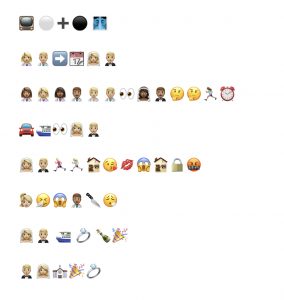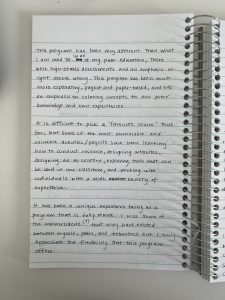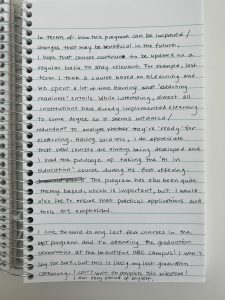Link #1: This is my response to Steph Takeda’s Task 3:
Hi Steph,
It sounds like we had similar experiences when using a speech-to-text tool to capture our stories! Similar to your experience, the very first thing I noticed was how unappealing the block of text was to re-read. The lack of paragraphs and errors in punctuation negatively affected my experience re-reading my story in written form. What speech-to-text tool did you use to capture your story? I used the dictation feature on my iPhone and it does have the ability to separate text into new paragraphs if you say “new paragraph”, but this obviously wouldn’t be included in an authentic oral story.
I really appreciate the differences you highlight between oral storytelling and written storytelling – most are differences I hadn’t thought of. The consistency of oral stories is a great one and reminds me of the game ‘Telephone’ that I used to play as a child and how the word / sentence was never the same when it got to the last person in the game. You raise an excellent point that there is flexibility with oral storytelling where the storyteller has the ability to adapt parts of the story based on the audience.
You mention another difference that written story telling requires a technology, whereas oral story telling does not. What about oral story telling through phone calls or through audiobooks – would you consider story telling through these mediums oral storytelling?
Shannon
Link #2: This is my response to Duncan’s Task 3:
Duncan,
It was a mistake to read your post around lunchtime! I am now craving a big bowl of ramen…maybe not quite as big as your friend Anna’s bowl though…
I like your candid storytelling approach; it certainly made me chuckle a few times. My favourite typo was the misinterpretation of Ramen as “Roman men”.
Similar to you, I also used the Apple dictation feature and we had several similarities in our analysis, mostly around the poor punctuation, haphazard comma placement and misplacement of periods mid-sentence.
While you call your text a result of your meandering, there is a charm when reading the collection of run-on sentences that describe the ramen that you have eaten. I can feel the joy of you reminiscing about the delicious and different bowls of ramen you have experienced. I wonder whether this ‘charm’ may be lost if your story was presented in written form, resulting in a more structured and rules-based body of text.
Finally, can you please clarify the best ramen you have had in Vancouver? It seems like Ramen Domo was a frontrunner (is this Ramen Danbo??), but then you also mention Gill para Ramen (is this Gyo Para Ramen??).
Shannon
Link #3: This my response to Lachelle’s Task 4:
Hi Lachelle,
The first thing I noticed (even before reading your reflection) was that I used a lined notebook for this task, whereas you used a blank piece of paper. My response is boring and structured as I wrote in neat, straight lines, left to right, and top to bottom. While I could have added illustrations or ignored the light-coloured lines and wrote diagonally, I didn’t even consider this, allowing the type of paper to impact the structure of my words. It’s also kind of funny to think about the entire paper industry that has emerged…offering blank paper, lined paper, graphing paper, dot paper, columnar paper, etc. There is some practicality behind these options but it also seems a bit unnecessary. If I wanted to sketch something, I could easily do this in my lined notebook, but I would probably opt to buy use a blank-paper notebook instead…consumerism in action!
You mention writing non-linearly and this relates to Task 5 (Twine task) that I just completed. It felt liberating to add thoughts as they came, not in any kind of hierarchical order or structured way. Your blank piece of paper for journaling allows for jotting down thoughts in this non-linear way, as they pop into our minds. You mention that you like to contain thoughts in particular shapes; why is this? And which comes first, the shape outline or the text?
You raise two really interesting points about literacy (in your hand-written journal entry itself) and the human element associated with non-mechanized writing.
It’s funny to think of those birds – illiterate when it comes to human’s English language. This doesn’t mean they can’t communicate, but they can’t in the way that we can. This also makes me ponder about humans who are illiterate in certain environments (e.g. when a human travels to a foreign country, where all signs and oral language are in a different language). Signage depicting rules still apply to them, despite being illiterate in that particular language! Tools such as Google translate have been developed and can help reduce barriers in these types of situations.
Your point about us all having a ‘personalized font’ is very insightful and reminds me of when I mark my students’ hand-written responses. I often start to learn whose response is whose, based on their hand-writing and without looking at their name on the first page. I wonder if/when the concept of signatures will become obsolete, particularly as electronic signatures, which sometimes are just names typed in a standard cursive font, are accepted. Without signatures, do we lose a personal identifier or perhaps it was not a strong personal identifier to begin with. What do you think?
Link #4: This is my response to Jennie’s Task 6:
Hi Jennie,
I was so eager to try and guess what show you’re depicting with your emoji story, but I’m stumped.
Does it have something to do with demons, drama, heartbreak, the police, and a father loving his son, despite his demons?? Am I on track at all?
Based on your first thought, it sounds like we both faced the challenge of trying to convey a complex show, using a limited set of emojis. Were there any imageries that you felt could not be captured with the emojis currently available? And if so, does this provide any insight into the creators of emojis? In my case, I felt limited by the lack of certain characteristics that are not currently available such as an emoji of a light-skinned character with brown or red hair. This detail would not capture the personality or rich character from the show I was trying to depict, but it would at least help to communicate which character I was trying to showcase.
Similar to you, I also used my iPhone’s Notes application to craft my emoji story and it’s interesting to see that we both split up our string of emojis into separate lines. To me, this made it feel like text is still in control, despite not using any text in the story. Despite no text being used, my emojis were organized as if in sentences and I used spaces between the lines of emojis, as if I was organizing paragraphs to separate ideas. What made you organize your emojis in lines and when were you prompted to start a new line?
Can you elaborate on some of the ‘important losses’ that you think are being lost in the shift to visual and multimodal texts?
Link #5: This is my response to Carlo DeFazio’s Task 7:
Hi Carlo,
Interestingly, we approached this task in a similar way by conveying our objects by the recognizable sounds they make (or the environmental sounds in which our objects are found). This may be partially due to Ernesto advising us to avoid simply describing the objects in our bag, but it also highlights that we both agree there are sounds that we have learned to associate with certain objects / environments. We also both refer to ASMR! It sounds like for both of us, it took longer to prepare this activity in audio form compared to preparing it in written (text) form. I mentioned that one reason for this was because I was inclined to write a script before recording my audio reflection, essentially doing double the work (written + audio form). Was this the case for you as well? You spoke so clearly, without um’s and ah’s so it’s not obvious to me whether you were reading off a script or not. I’m also curious what technology you used to record and edit your audio clip? One difference between our two tasks was your addition of background music. I didn’t think of this (I wish I had!) and I think it can impact the tone of your entire audio clip. For example, you chose an upbeat song, but had you chosen suspenseful music or a sad song, it would have completely changed the feel of your task. This also makes me think of movies / tv shows and how sound effects and the soundtrack can immensely impact the overall experience.
Thanks for your redesigned Task 1, I enjoyed listening!
Link #6: This is my response to Robyn Bernsen’s Task 8:
Hi Robyn,
Before diving into your Task 8, I went back to your Task 1 to get to know you via ‘what’s in your bag’. I’m so glad that I did, because it turns out we both teach at BCIT! I teach in the School of Business, specifically in the Financial Management program. Are you on campus often or do you teach remotely?
Similar to you, I found this task more challenging than anticipated and it felt ‘wrong’ to cut pieces and deprive a future listener of the diversity of music from our planet. I ended up taking a purely geographical approach, mapping out where the pieces and artists originated, and my final 10 pieces represent a collection of geographically diverse pieces. In doing so, I only kept a single piece originating from Germany (I cut all of Bach’s pieces (ah!) and kept one of Beethoven’s pieces and similarly, I only kept a single piece originating from the United States.
You pose whether this task would be easier or harder if the Golden Record was created in 2024 and I think it would be even harder today. The sheer volume of music pieces available today would make it more difficult and I think it’s also important to consider that music pieces nowadays have been ‘published’ in different ways. There are music pieces by well-known artists who have formally ‘published’ their work via records and labels, but there are also a lot of musical pieces shared by people on platforms such as YouTube that we should consider as well. I wonder if different forms of audio pieces such as podcasts or audiobooks should also be considered…
Considering the theme of diversity that you discuss, I wonder how age and stage of life impacts one’s perception. For example, a toddler’s most ‘meaningful’ 10 pieces may be very different from an adult’s most ‘meaningful’ 10 pieces. Perhaps in choosing 27 songs that represent Earth, we not only have to consider the diversity of the pieces themselves, but also ensure a diverse group of individuals are involved in curating the pieces to begin with.



